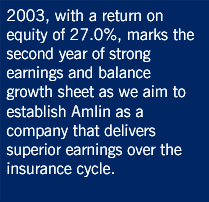|
 |
|
|
 |
|
|
 |
 |
 |
|
OUTLOOK
The short term outlook is excellent and we anticipate another year of
strong performance with a good return on capital. At 31 December
2003 we had a pipeline unearned net premium of £400 million
(2002: £321 million) which will be largely earned in 2004. This
is mainly business written in 2003 at very good margins.
While premium rates in a number of classes have come off the
exceptionally high levels experienced over the last two years, the
margin potential in most classes remains very good. By 29 February
2004, we had written 34% of our budgeted income for the year,
with a reduction in average renewal rate of 2%.
Other factors which will contribute to a favourable underwriting
outlook in the short term include the increase in our owned
underwriting capacity by 16% for 2004 and lower Lloyd’s charges.
Against this a continued low level of loss experience should not be
taken for granted and a continued weakness of the US dollar will
mean that US dollar profits will translate into less sterling.
We believe that the current year is capable of delivering
acceptable investment returns on our combined solvency and
technical funds which grew by 26% in 2003. While in the US
there is a short term expectation that interest rates will rise from
45 year lows and will put pressure on bond capital values, we
expect the US economy will lose momentum towards the year end
as the impact of fiscal and monetary stimuli recede. Equally the
ability of the major European economies to gain momentum is
being impeded by the strength of their currency. We do not
expect inflation to become a major global problem in the
foreseeable future. This suggests that relatively low interest rates
will prevail in Western economies and returns on our fixed income
investments will be modest by the standards of the last few years.
Accordingly, we have reduced our long term investment return
assumption for bonds to 4.5% from 5.5%.
Back to top
In the medium term, our planning assumption is that the
industry will remain cyclical, with the principal driver of the cycle
continuing to be the availability of capital. If the last cycle were
to be repeated, we believe that the 2004 and 2005 underwriting
years will be years where good margins can be made. In reporting
terms this means good prospects for 2006.
However the dynamics of the industry are such that this view
may prove to be pessimistic. Many companies still face ongoing
adverse reserve development from asbestos and other casualty
risks. For them it will be important to maintain current margins
to offset these losses. To illustrate the scale of this issue,
Moody’s recently estimated the industry was US$30 billion
under-reserved.
Much of the non-life insurance industry invests heavily in fixed
income securities. With these portfolios, during the 1990s the
industry benefited from falling interest rates. It is unlikely to see
this repeated, adding to the pressure to write for good
underwriting margins.
Additionally, greater discipline is evident in parts of the industry.
Increasingly advanced modelling techniques are being employed,
encouraging more disciplined underwriting and increasing
demand for high level reinsurance protection. Closer to home, at
Lloyd’s, we have seen the introduction of Franchise management
that is expected to increase performance within the market.
The impact of this is already being seen with a more rigorous
approach to Lloyd’s oversight of franchisees business planning
and the control of ‘quota share capacity’.
Amlin’s business is now better structured than during the last
cycle with a reorganised underwriting operation, built around
underwriters who have performed well through the cycle. A shared
underwriting philosophy now exists among management and
underwriters, focussing on gross underwriting discipline, achieving
an acceptable technical price for risks and downscaling activity if
acceptable terms cannot be achieved. This, and the improvements
we continue to make in building the business, and in analysing
risk and performance enables us to look forward with confidence.
|
|
|
|
|
|